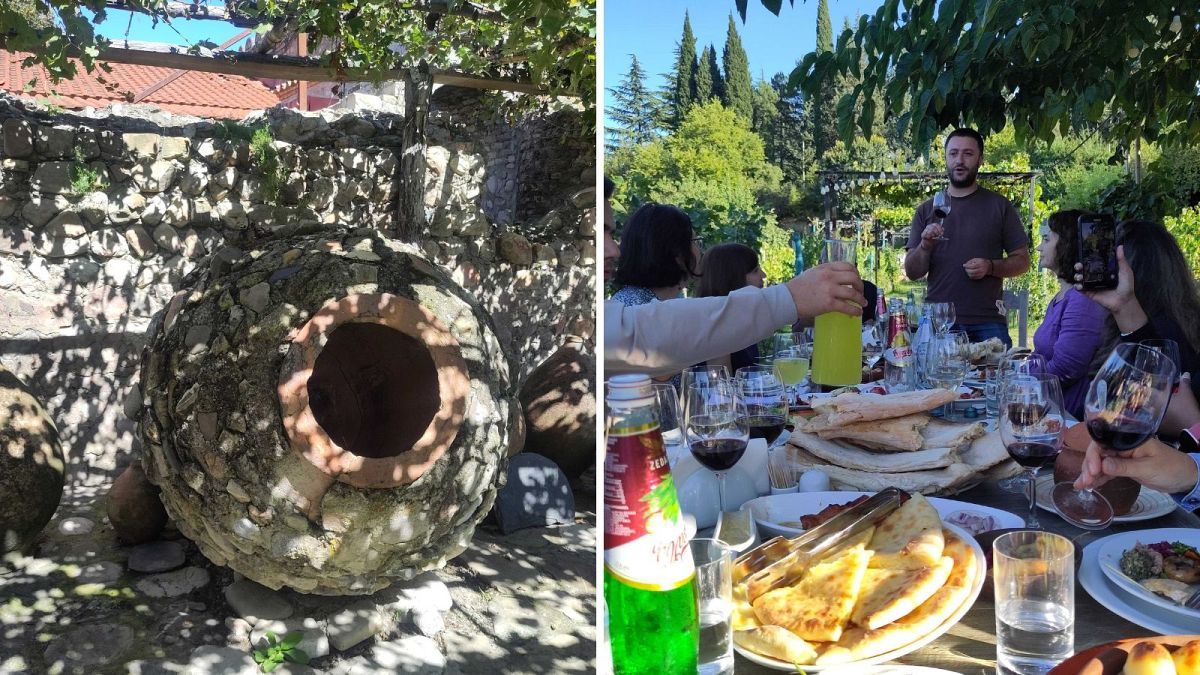Wine, dine and wind through mountain roads on a visit to Tbilisi and Kakheti.
It is in the basement of the Georgian National Museum in Tbilisi, gold burial items glinting in the darkness, that I first get a sense of how deep the connection to the land runs here.
A lion statuette, its sun-like face trusted to escort the dead into the afterlife, gleams beside a beaded necklace adorned with gold globules. Across the room lies an amethyst ring inlaid with tiny pieces of gold with a skill that still puzzles experts.
From archaeology to the ancient practice of Qvevri wine-making – where clay vessels of grapes are planted in the “belly of the earth” – the Georgian belief in ‘motherland’ is a strong one.
Visiting in late September, I was lucky to see many more national treasures – and drink many, many glasses of wine.
If you’re keen to experience both on a trip to this beautiful Caucasian country, here are my highlights.
Why is Georgian wine so special and where can you taste it?
Georgia, we’re proudly told by our guide, is the country where men first conquered the grape. A claim that that has been scientifically proven (for now) by wine residue in an 8,000-year-old pottery jar.
On our drive through the stunning Gombori Pass to the Kakheti region, our guide Kartlos – founder of Inter Georgia Travel company – explains the labour of love that goes into making Qvevri wine.
After months of tending to the vines every day, families press their harvested grapes and leave them to ferment underground in Qvevris for six months. “It’s like a baby you’re taking care of,” says Kartlos – a year’s work rewarded by the moment a guest turns up and declares, “wow, what a wine.” Hospitality runs deep in Georgian culture.
“We say if a man makes a good wine, he is a good man. Because a bad man cannot make good wine. That is our belief,” says Kartlos. The ancient Qvevri wine-making method is protected by UNESCO as an intangible cultural heritage; “so when you’re tasting Qvevri wine you’re sipping UNESCO,” he adds.
For Georgians, what makes their wine-making so special is not simply its age but the unbroken nature of the tradition, even when the Soviet occupation forced it largely underground.
Where are the best places for wine tastings in Georgia?
If you’re after a quasi-religious wine experience, Alaverdi monastery is the place to go.
This Orthodox 11th century cathedral – with parts dating back to the 6th century – is magnificent in itself. Little chunks of glass bathe its plain interior and faded frescoes in a peaceful, aqua light.
You can tour the cellar within the monastery walls and sample Saperavi and Rkatsiteli – a punchy red and honey-noted amber wine – among others.
30 kilometres away through Telavi city lies Shumi Winery, where another delightful wine degustation awaits. It boasts the world’s largest collection of living vines, and is on a noble mission to restore old Georgian grapes.
The winery grounds are a truly lovely place to pass an afternoon, with Disney-esque touches to the decor and a sprawl of activities on offer; including grape-stomping and traditional ‘shotis puri’ bread-making.
Just up the road, Tsinandali Estate hotel is a supremely comfortable place to rest your head, with luxurious amenities including an infinity pool overlooking the Caucasus Mountains.
It seamlessly borders the Chavchavadze Estate – home to the 19th century prince and poet Aleksandre Chavchavadze – whose residence is maintained as a museum. Naturally, the museum also features a wine cellar where you can enjoy more fine Georgian wine.
If you’re staying put in the capital, Tbilisi Wine Museum is also well worth a visit, with another snack and wine sampling helping to commit the viticulture lesson to memory.
Looking out over the city is the Mother of Georgia statute – bowl of wine in her left hand, sword in her right. I’m told on good authority by Kartlos that it’s a fitting representation of the Georgian character – generous and friendly unless you cross a line.
Where are the best places to eat in Tbilisi?
If all this talk of drink has whet your appetite for some authentic Georgian food, there’s an abundance of options.
There’s something characteristically generous about the cuisine; the almost indecently delicious ‘khachapuri’ (cheese-filled bread), the richness of ‘ajapsandali’ vegetable stew and the fullness of ‘khinkali’ dumplings.
Rigi restaurant is a sophisticated spot for a smorgasbord of Georgian food – with the space cleverly designed like little streets to give you a glimpse into different food stations.
Barbarestan has the best origin story I’ve heard. The founder chanced upon the cookbook of Barbare Jorjadze, a nineteenth century Georgian princess considered to be the country’s first feminist, at a flea market in 2015. The family uses hundreds of her traditional recipes as the guide for their delicious menu.
For rooftop garden ambience and another gorgeous menu, Keto and Kote is also a must-visit. As is Stamba restaurant for an avant-garde take on Georgian classics in a cavernous interior.
Adjoining Stamba Hotel is Rooms Hotel Tbilisi – both in a huge Soviet-era publishing house – where I stayed in laid-back splendour.
My first week-long visit to Georgia has left me eager to return; to soak up more of its earthly culture and countless churches. And to seek out new experiences now on my radar: Tbilisi’s enormous botanic gardens; the bears, birds and wolves of Tusheti; and the night train from Tbilisi to Batumi on the coast.



